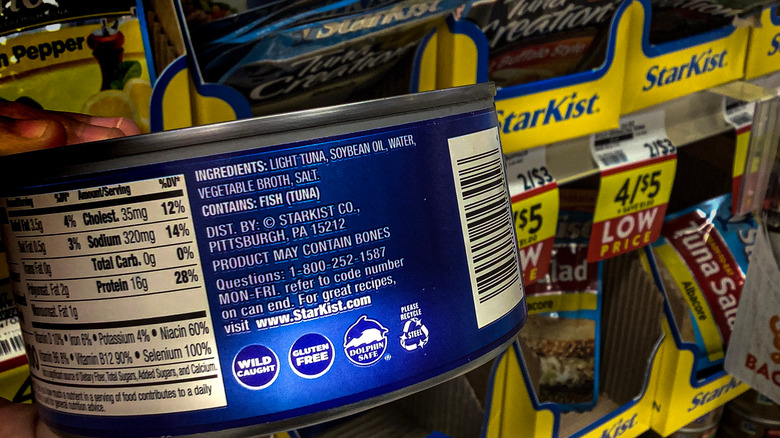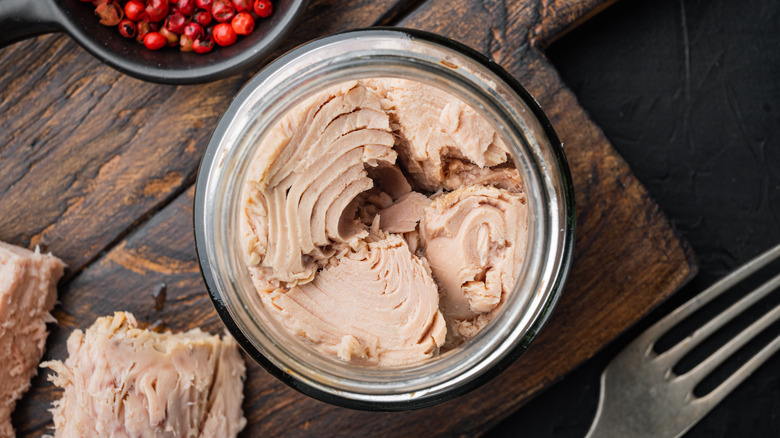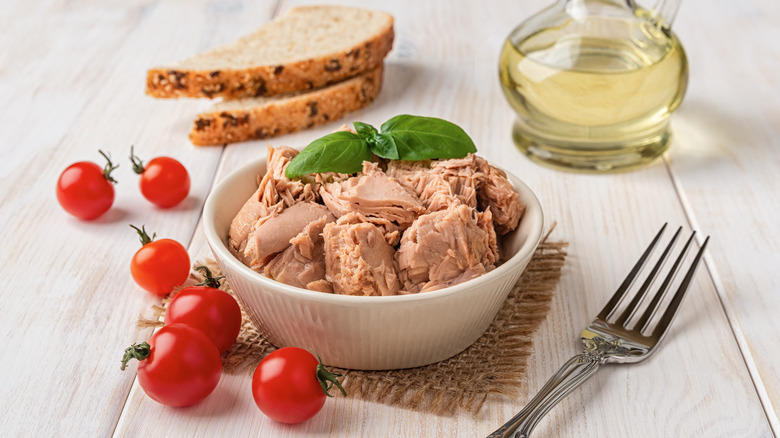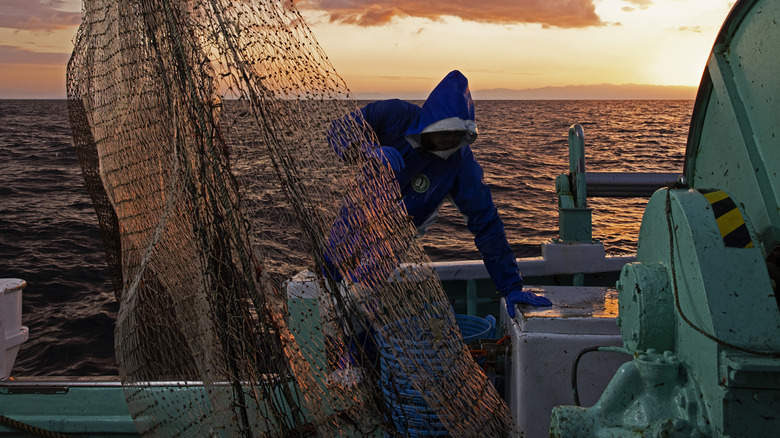What Does It Mean When Tuna Cans Are Marked 'Dolphin Safe?'
Have you ever peered at a can of tuna and been unnerved by the peculiar disclaimer that it's "dolphin-safe?" Has your mind wandered to unsavory places in which you're now thinking that there is a substantial amount of dolphin meat in your canned tuna? Rest assured, most of the time this is not the case. Furthermore, this isn't even the real reason to avoid eating canned tuna.
As defined by the NOAA Fisheries website, a can of tuna that is marked dolphin-safe denotes that it "shows compliance with U.S. laws and regulations of tuna fishing operations." The site also notes that due to concerns about dolphin protection in tuna fishery, the Dolphin Protection Consumer Information Act came into effect in 1990. This was created to ensure that "no purse seine net or other fishing gear was intentionally deployed on or used to encircle dolphins during the fishing trip in which the tuna were caught, and that no dolphins were killed or seriously injured in the sets or other gear deployments."
How is tuna harvested?
The Spruce Eats notes that while some fishing practices result in unintended dolphin mortality, the dolphins have never been the target for a product. However, it's especially laborious to keep the tuna and dolphin completely separate when harvesting. The dolphin/tuna connection was first noticed and capitalized on about 70 years ago when fishermen were able to easily spot dolphins and use their location to determine that tuna must be nearby. Where does the dolphin-tuna connection stem from? Per the NOAA, dolphins and yellowfin tuna travel together for some unknown ecological reason.
In the past, when tuna was caught, some dolphins would be collateral damage due to getting caught in the nets (per The Conversation.) Depending on the capturing method, the surrounding marine life, such as dolphins, can be minimally harmed or severely affected. The Spruce Eats states that "earning the dolphin-safe label requires allowing an independent observer on each fishing vessel to confirm that dolphins were not viewed, chased, encircles, killed, or seriously injured during the tuna harvest."
Many advocacy groups don't think this is enough, though. While dolphin mortality has gone down exponentially in recent years, they still maintain that not a single dolphin should perish due to tuna harvesting. Furthermore, tuna harvesting can traumatize dolphins by separating calves from families and displacing the dolphins, so the hope is that there's a way to mitigate damage to other sea life when fishing for tuna.
Is dolphin-safe always ethical?
The Conversation also poses the question, "how tuna-safe is dolphin-safe," which is an important question that often goes unasked. The thought is that some of the dolphin-safe labels may be misleading or provide a false sense of security. This does a disservice to the tuna, and these labels bear no responsibility or accountability for the ethical harvesting of the tuna itself. The outlet ends the piece by stating that "it isn't enough just to know your tuna is dolphin-friendly," echoing the point that the quality of the tuna at hand is just as important, across the board, from eco-conscious, health, and ethical standpoints. And while there are some tuna brands, however, that get top marks for dolphin safety, not all are as diligent — or truthful.
In 2019, there were reports of three big-name American brands fraudulently labeling tuna cans as dolphin-safe. Per Newsweek, there is even a documentary called "Seaspiracy" which was made to shed light on the topic and encourage viewers to convert to a plant-based diet, eschewing seafood altogether due to ethical and animal welfare concerns. The documentary specifically references an experience in which a fishing company working with a dolphin-safe canned tuna brand "killed 45 dolphins to catch just 8 tuna."
The future of tuna fishery
Things appear to be looking up, though. Over the past five years or so, and since the release of the "Seaspiracy" Netflix documentary, there has been a marked improvement within the canned tuna industry. Furthermore, Sierra Club states reports that Greenpeace, a company that lists the 20 most dolphin-safe brands, is a great resource to check prior to heading to the grocery store to pick up canned tuna. Here's a link to the most recently published Greenpeace report.
Sara McDonald, a senior fisheries scientist at Monterey Bay Aquarium, told National Geographic that "dolphin mortality in the 1920s was 130,000. In 2018, there was 819 documented deaths," (via Newsweek). While it's impossible to guarantee 100% oversight on the issue, it's clear that the fishery industry is going in the right direction in taking the necessary steps to help protect the dolphins while harvesting tuna in a sustainable, ethical manner. Ideally, the dolphin mortality number will be well below the 2018 figure, and perhaps, sometime in the near future, it will be at zero.



